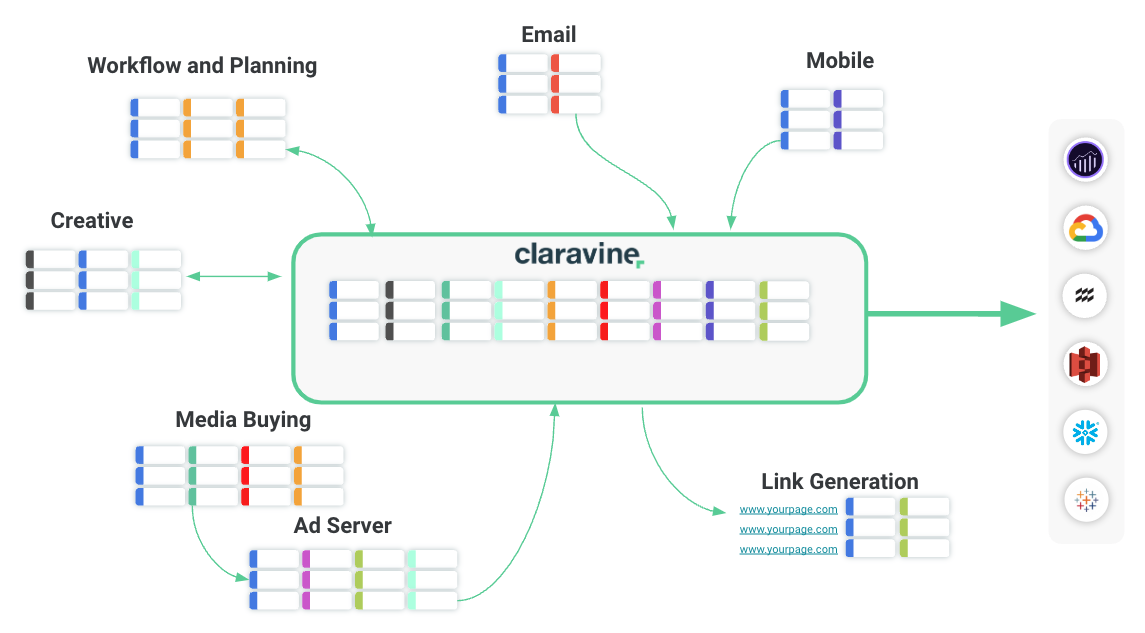How to Enhance the Content Supply Chain with Better Data
For a few years now, Adobe has been advocating a systematic approach for efficiently planning, producing, and delivering content: the content supply chain. This framework was developed to help marketing teams that had long struggled with hand-offs, reviews, approvals, and asset management across tools and teams.
The content supply chain framework connects the people, processes, and technologies that brand and marketing teams use to deliver the personalized experiences that consumers increasingly demand. By building these connections, content supply chain solutions address common breaking points across the key stages of content development:
- Applies consistent processes to project planning, helping avoid unnecessary revision cycles or poor resource management
- Automates workflows and breaks down silos throughout production, allowing creatives to spend more time on high-value work rather than repetitive, manual tasks
- Enables efficient delivery of personalized experiences across channels by centralizing asset management and fragmented tools
Without a streamlined framework applied across every stage of planning, producing, and delivery, enterprise teams will struggle to meet the ever-increasing demand for content.
During the 2023 Adobe Summit, Adobe went one step further and formalized the content supply chain system into an end-to-end technology solution. By integrating workflows across core tools like Workfront, Experience Manager, and Creative Cloud — while layering GenAI capabilities throughout the ecosystem — Adobe’s content supply chain promises to accelerate the production of personalized content at scale.

And there’s one component of executing a successful content supply chain that can’t be underestimated: standardizing and leveraging the metadata surrounding every campaign, asset, and behavior.
Deciphering the data challenges in the content supply chain
Content supply chain solutions streamline tremendously complex workflows — but enterprise ecosystems rely not just on quality content, but quality data. And if the data produced and managed throughout the supply chain isn’t standardized and accurate, it can threaten to undermine your content’s success.
Enterprise marketing data can get very messy, very quickly. In order for organizations to track and measure how content travels throughout the digital content supply chain and performs on external channels, teams need to capture and understand consistent metadata.
This means content needs to be named, tagged, categorized, and organized within taxonomies in a consistent way across the entire supply chain — and beyond. But standardization at scale is no small task, thanks to the complexity of content, distribution of teams, and siloed approach to managing metadata.
Ever-increasing complexity and volume of content
The average enterprise marketer has hundreds of marketing and ad tech apps across their organization, with a tangled web of system integrations connecting ad servers, email providers, streaming platforms, social platforms, and dozens of other channels. And the complexity of the tech stack is exacerbated by the sheer volume of campaigns and assets managed by an organization, especially as brands produce more localized or personalized variations.
This means that any point of manual intervention around content metadata — such as relying on naming conventions or cataloging in spreadsheets — inevitably leads to errors. Especially as metadata needs to be entered and translated across external activation platforms, these manual processes break down due to inconsistencies in fields, unanticipated downstream changes, and good old-fashioned human error.
Lack of standardization between teams
Handing off campaign plans and content assets between internal teams can be enough of a challenge, especially when they maintain different installations of a DAM or Workflow Manager. But most enterprise marketing teams also work within incredibly fragmented ecosystems, with multiple brands, agency partners, and outside consultants around the globe.
With these disparate teams, standardization is difficult to implement and nearly impossible to enforce. When a campaign or asset deviates from the usual naming conventions or preferred taxonomy, it easily falls through the cracks. Those inconsistencies aren’t usually detected until data is needed — but by then, it’s already gone missing.
No central place to manage metadata
Despite the complexity and scale of enterprise content, many organizations don’t maintain a single source of truth for campaign metadata. Our research found that among companies spending $50M or more on digital advertising annually, emailing around Excel files or Sheets was the second most-common way to share data. Without a system in place to facilitate a single taxonomy or even connected, translatable taxonomies, metadata remains heavily siloed and rarely aligned across platforms and teams.
Difficult to gather data for analysis
This fractured, manual approach to metadata throughout the upstream planning, building, and deploying of content inevitably culminates in a difficult task for downstream analytics. BI teams report spending days or even weeks trying to contextualize, clean, and understand data because of inconsistent formatting or inaccurate names.
This process becomes especially complex when data is ingested from third-party sources like Google or Meta. But without a clear understanding of campaign and content performance, analysts can’t produce the actionable insights business leaders need to make informed decisions.
All made better and worse by AI
Every pain point on this list stands to become exponentially more challenging with the rise of generative AI. Gen AI provides an incredible opportunity when it comes to producing higher volumes of content with more iterations at a faster rate. There are also many exciting tools being developed to assist in content tagging and comprehension (including Claravine AI). However, as teams use Gen AI for these purposes, the maze of metadata will only grow more difficult to navigate.
Bottom line: if you don’t facilitate standardization of metadata around people, process, and technology, you won’t be able to use or rely on the data produced along every step of the content supply chain. And this becomes even more true in an AI-enabled content world.
The costs of mismanaged metadata in the content supply chain
When metadata isn’t standardized throughout the entire content supply chain, teams find it challenging to get a full picture of compliance and brand safety, their content performance — or even what content they have in the first place.
Difficulty understanding content performance and ROI
Without clearly defined and consistent metadata, it’s nearly impossible to compare the performance of content and campaigns — or calculate the ROI of your assets. And without a clear understanding, you can’t make the strategic improvements needed to improve conversion rates or customer experiences.
Lower certainty of regulatory compliance and brand safety
Organizations that can’t rely on accurate metadata risk falling behind when it comes to brand safety or compliance. Having full visibility into when and how data is used helps you achieve data integrity, and proper tagging makes it possible to ensure every asset goes through the proper approval channels — an absolute must for brand safety in the age of AI-generated content.
More challenging collaboration across teams
When teams aren’t using a standardized approach to naming and tagging assets, they literally aren’t speaking the same data language. Misunderstandings occur, and team members waste valuable time trying to communicate about or share specific assets.
Wasted resources around content creation
When teams can’t easily find existing assets due to incorrect tagging or inconsistent naming, work ends up being duplicated unnecessarily — or valuable assets go unused. Given that content creation is often one of the most costly and time-consuming steps in the supply chain, wasting these resources can significantly drive down the overall ROI of your content, creative teams, and campaigns.
How automating your data standards enhances the content supply chain
In order for organizations to address these data challenges and realize the full value of their content, it’s essential to automate and standardize metadata across the entire content supply chain.
This is where Claravine comes in. Our platform, The Data Standards Cloud, creates a source of truth for content and campaign metadata across every process, every team, and every layer of the tech stack, including Adobe’s content supply chain solutions, but also beyond. By connecting metadata across the content lifecycle, teams get a complete picture of performance and ensure the integrity of their content from ideation to analytics.

Here’s how it works: Teams configure templates in The Data Standards Cloud to guide how metadata needs to be structured and collected across every campaign and project. Through direct and indirect integrations across Adobe solutions like Workfront, Experience Manager, Experience Platform and Analytics, marketers can gain control over their data language across the content supply chain. Campaign objects, tracking URLs, UTMs, Asset IDs, unique identifiers, placement — all can be specified and standardized from the planning stage to analytics.
First, let’s consider content and creative processes. Creative production is approved and new assets are built and uploaded. Often these assets have a number of missing or improperly structured metadata fields. Asset data can be imported into Claravine’s platform, where missing/incorrect data can be quickly identified from one single view. Issues are flagged so they can be easily corrected. If your requirements changed, you can adjust your standard and retag or rename assets- whether you have 10 or 10,000.
What about marketing and ad ops? It’s easy to manage campaign metadata with pinpoint accuracy. Configure Claravine templates to your campaign standards, then import, transform, and correct campaign metadata to avoid disconnected data and broken customer experiences. You can also review and validate ad creative alongside campaign metadata, or enhance segmentation with a taxonomy powered by AI. With standards, you have an easy way to align creative assets with campaign data for faster reporting.
Why does this matter? Data teams get clean, consistent data flowing directly into Adobe Analytics and other data tools so marketers can make fast, confident decisions. And when requirements inevitably change again, Claravine helps your marketing and data teams collaborate. Mapping and adjusting fields and formats in templates quickly controls how data is received and understood.
As the content supply chain streamlines workflows across applications and teams, Claravine ensures the content metadata is created and organized in a reliable, consistent, and useful way. This helps alleviate the burden of manually checking in, cleaning, and translating data — and makes it possible for organizations to scale their content and campaigns without compromising on data quality and visibility.
By enhancing every stage of the content supply chain with consistent and standardized metadata at scale, Claravine delivers improved data governance, more efficient workflows, more accurate analytics, and tighter collaboration between teams and systems.
We’d love to show you exactly how Claravine can improve your data integrity and content ROI. Get in touch today, or come find us at Adobe Summit to learn more.



